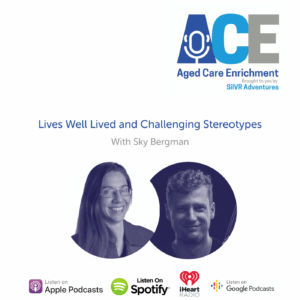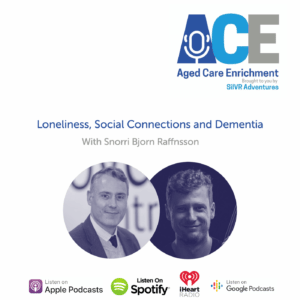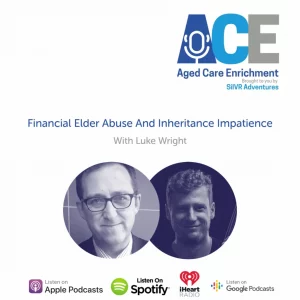Leeroy William is the President of the Australian and New Zealand Society of Palliative Medicine and Clinical Director of supportive and palliative care at Eastern Health.
Transcript
Ash de Neef: Leroy, thanks for joining us on the program today.
Leeroy William: Thanks, Ash. Thanks for the opportunity to be here and chat with you.
Ash de Neef: Yeah, it’s a pleasure for us as well. And we’d really like to talk a lot about palliative care today. So can we start very broadly for people who might have a varied opinion about what palliative care is and what it can be. Can you give us an overview of,what it looks like and all the things that might encompass?
Leeroy William: So this is a very common question and I think the knowledge about what palliative care is, is very different, not only in the clinical world but also in the public as well. So palliative care is an inter-professional active approach to managing people at the end of their life that considers those people as per their physical needs, their psychological needs, their social needs and their spiritual needs.
And you could argue that this is the kind of approach that we should be taking within healthcare overall. The word is holistic that encompasses all those areas. And I think that everyone who comes to a hospital setting or has a health care issue, they are essentially then more vulnerable than they normally are.
And so when you’re looking at people who are vulnerable, the best way to look at them is all the areas of their vulnerability. So that could be a physical illness, or it could be psychological like I say. It could be standing they have within the social setting of our communities. And it also can be the existential issues of how they deal with who they are as an individual on this planet, and religion is obviously part of that, but not the complete picture.
It also encompasses end of life care, because it’s usually when people have a life limiting illness. And so that’s when we are usually involved and that definition of when we get involved is usually the last year of life. And that’s, difficult to try and predict. So that’s why there’s a bit of problem with, knowing when we can be involved.
There’s also end of life care as a sort of term might also relate to the last few days, hours of someone’s life as well. So it becomes very difficult with the terms that we use sometimes.
I think the other thing to say in the definition is also that palliative care can occur in whichever setting that person should be. So it should be available in the bed the person’s in, if you want to look at it from that perspective.
But obviously people don’t have to be bed bound, they obviously would be living their lives, and in that last year of life may be deteriorating. And wherever they are, we need to try and be available to support them.
Ash de Neef: So I think that perhaps what some people might be thinking of when they hear the words palliative care is end of life care then, is the final few hours and prioritising comfort. Can you maybe just give us an example of some of the things. You’ve spoken about the areas in which palliative care will extend to, but maybe some of the activities or the processes that you might go through that are unexpectedly part of palliative care.
Leeroy William: Yeah I think where people forget or don’t consider palliative care is often alongside other treatments. So there are many things in medicine that we can’t cure anymore or – we used to deal with things that we could cure.
And even with cancers we’re treating people and they go into remission, but they will often have a relapse. And we’re always monitoring people with cancer to see whether they’ve got any relapse coming on and then trying to deal with that.
So when palliative care is involved, those symptoms that people have alongside that management like cancer pain, for example. If we can manage that pain well, then they will look better when they go and see the oncologist, and they won’t have a treatment break because of them struggling with a symptom like cancer pain.
So often we’re involved alongside treatments to ensure that people don’t get those treatment breaks, cause if you have a break in your treatment, then that’s an opportunity for the cancer to progress more. So you want to make sure that people have the best support possible alongside their active treatments for their cancer.
So I used to see people with head and neck cancers, and the intention of treatment was to cure them. But alongside that treatment, I was providing pain management. And so, by coming in at that point, it would also allow me to treat them holistically. So to ask about other things that are going on for them and trying to think about how they deal with this illness in the context of their life and what their life has meant to them. And so how we can then support them to maintain that quality of life or the important things in their life.
So that’s one aspect is that kind of symptom management perspective.
Leeroy William: I think sometimes the other thing is we in medicine there’s some uncertainty that we have to live with. And I think as scientists or as academics, sometimes we like to explore these areas so we know as much as possible, but there’s always the unknown.
And so sometimes teams and doctors find it difficult to grapple with that when we’re trying to make a decision about someone and we can continue to explore and investigate and treat and sometimes lose sight of the person and what is important to them.
So often from a palliative care perspective, we can be part of that conversation to just say, “hang on a minute. We’ve spoken to the patient and the family. We can advocate for them in this, difficult system we work in to ensure they understand what’s going on. They understand the choices that they need to make and whether it’s important to them as well.”
So that’s another area and the other, the final area that palliative care can come in is when there’s traumatic experiences within the health system. So often we’re supporting teams to deal with difficult deaths that occur in the system and allowing them to debrief to us and giving them the opportunity to see things from a different perspective.
So those are some other areas. I think that we, probably don’t get the recognition for what we do. And sometimes people are referred to us saying that they’re dying. “This person’s dying they’ve got three weeks left or whatever”. And, we change the medication around, we look at things in a different way and they’re not dying and they’ll go on for an, another six months or so. These stories happen all the time with palliative care and we never hear that kind of side of, where we can make that difference.
Ash de Neef: Does that kind of underlie a difference in diagnosis or difference in outlook between palliative medicine and general medicine that there’s these people who are being referred to you perhaps incorrectly?
Leeroy William: I think it’s an issue with prognostication. So we’ve got to remember that prognostication, it formed one of the three pillars of medicine in the past; diagnosis, treatment and prognostication or prognosis. And we’re very good at diagnosing things. We’re very good at treating things, but prognostication, we haven’t really done very much work.
And if you look, if you ask any medical student, how much, teaching they’ve had on prognosis uh, they’ll sell zero. So, when doctors give a prognosis, it is based on some sort of guesstimate. But if they give a number, it’s probably not accurate.
So I mean, I think that’s where the problem rises because sometimes people come into hospitals and they look pretty bad, and you can say well, “look, it looks to me that they were pretty bad and given all these lists of illnesses they’ve got, I don’t think they’ve got very long”.
And so they are given this prognosis, and then when you give them, you know, old people especially, they need a bit of time. They need time and a bit of TLC, and thinking about the drugs and thinking about what else has been happening in the past few months. Then you can start to put the pieces together and work out what’s been going on and then you can make a better prognosis because you’ve got more information.
And you need to listen to the families. The families know people better than we do. And so they will have a perspective on the deterioration that you’re seeing. And when they come into the hospital, it’s like a snapshot of that deterioration, but we don’t go back enough to see well, “how long has this been going on? And how long has this deterioration been happening?” And that might give us a better idea – there’s an art in that.
And I think that’s where there’s the difference because unfortunately clinicians are not taught in looking at that prognosis and also communication of that prognosis is also another thing that needs to be looked at.
Ash de Neef: One area is you mentioned that older adults, one area in which palliative care is going to be actively involved as in the end of life for older adults. And a lot of our listeners are in the aged care space. How is palliative care taught and spoken about to healthcare workers, particularly aged care workers?
Do you have any background on that?
Leeroy William: So I worked in the UK then New Zealand and then came here and i’ve done a bit of community palliative care. And I certainly, as I was a GP, so I went into aged care facilities in the UK quite a bit and seeing different people. And I think that palliative care generally from an undergraduate perspective is taught on an average of a week in the curriculum of five or six years. So it’s not taught hugely anyway.
And the aged care sector, I think that some of that comes through where there’s no extra sort of education that necessarily happens. Unless those community, palliative care organisations go in and support aged care. And that’s difficult because they’re also supporting the rest of the population.
There are some initiatives ELDAC from University of Flinders. They’re doing some work in aged care to try and improve that education. And often when we deliver education in aged care, it’s usually on the basis of a patient that we’re working together with. Or it might be in relation to educating staff and sometimes the staff don’t get a chance to come to those education sessions. It may well be some of the more senior staff that get to go, and the more junior staff may not be on that shift that day, or, the resources are not there and you hope that the senior staff will pass that information on.
Leeroy William: But having the resources to educate people about palliative care in aged care is, going to be a hugely important thing going forward with the Royal commission. But also if you think about most people who move into aged care, many people die in the first eight weeks. And then the average I’ve heard different variations on this. It might be a year or two years might be the kind of time frame that someone would be there.
And I’ve also heard from the palliative care outcomes collaboration, Kathy Eagers mentioned that, in aged care, it’s probably 50% palliative care patients and 50% geriatrics patients. But those geriatrics patients will obviously become palliative care patients down the line. And we have a good collaboration with geriatricians as well. We should be working together, because the ageing population is something that we’re all going to have to manage.
And even in general medicine in the hospitals, the average age of the person coming in is getting older and they’re more complex because they’ve got cognitive and physical frailty. And they are more complex because another way of looking at complexity is the more you talk to someone, the more complex they are, they have a history that is different and individual.
And they provide their own perceptions of their view of life and how they’ve lived their life. And to understand that the best you can understand that will enable you to treat them in the right way.
Ash de Neef: Yeah, fantastic. And if we just highlight that approximated fact there, that maybe half of people who are in aged care will be in geriatrics and half might be in palliative care. Does this kind of indicate that we should be starting palliative care in those spaces a lot earlier than is being started already?
Leeroy William: Yeah, I would agree with that. I think that that enables us to look at symptoms. The geriatricians can look at areas of maintaining their function in terms of their ageing process, but we can also look at any other symptoms from their illness and together we can work on the psychosocial and existential issues.
There are some organisations that are trying to also help in this space. So in our organisation at Eastern health, we have been given some money by the government to extend our consult service into aged care. So we’ve got a nurse practitioner and a doctor. So the nurse practitioner is, Louise Thai, and the doctor is, Heidi Gregory, and they’re going into aged care facilities and supporting the discharge from hospitals or the pal-care units.
So that we’re usually in for about four to six weeks opening up conversations with GPs and families, planning for any deterioration, working with residential In-Reach services and working with community palliative care services as well. So we’re getting together and trying to make sure everyone knows what’s happened, where they are in their trajectory, what needs to happen to control their symptoms. And also have a plan in place for if they deteriorate to try and avoid those unnecessary hospital admissions and seeing whether we can manage something in the facility.
What we’ve found with our study is that, a lot of this work could be done by a social worker. And so, I’ve been working with an organisation called Care Guidance to look at how we can get social workers into aged care facilities from a palliative care perspective.
Leeroy William: But they’re required, you could argue, in any aged care setting because the work that needs to be done involves the skills that many social workers have. Which is looking at that person as an individual, looking at the psychosocial issues that their illnesses couched in and also that grief and loss counseling.
And there are many people in aged care who bond with others to get through this difficult time of transition from independence to dependence. And those other people might die during the course of their time in the facility. And how’s the grief also dealt with them in that way?
So, we all have grief and loss as we get older about losing the ability to do certain things. And so in aged care if you have people that are also relying on others around them, this is like a little community, supporting each in dire times. Then when they lose those people that have been their strength we need to also be able to support them through that loss as well.
And so I think social workers have a huge role to play in the aged care sector. And we certainly working to try and enable that to happen.
Ash de Neef: And that grief would also be felt by some of the aged care workers who are in the space and losing people there. And I can see that having social workers or having some sort of program there to support the workers would be very helpful too.
Leeroy William: Very much. I mean I’ve known some people be very hugely affected by the death of someone in an aged care facility. Cause they’ve been looking after them and get attached to them in a very different way. And we’ve known people come to the hospital to just visit the person they’d been looking after in the facility, just to sort of make sure they’re okay.
So in the past I’ve certainly seen that. I think it would be, we all need to think about that. We see death and dying a lot in our hospitals and that’s one of the reasons I was involved with Schwartz rounds as a way of looking at the emotional aspect of what we deal with in healthcare and enabling people to have the opportunity to speak about those experiences.
We’re often told in healthcare that we shouldn’t engage our emotions should be sort of held back from the work we do. And that’s, true to a degree. We don’t want our emotions driving the kind of clinical care that we’re delivering in some respects and clouding our judgment.
But we do know we need to be human. And I think when people are at the end of life, or certainly if they’re getting older we need to maintain that human connection. And um, it’s more important. It’s important in the whole of healthcare, but it’s probably more important that time because it’s that human connection that really people need.
Otherwise you become very task focused in your care and you don’t actually engage with the person that’s in front of you.
Ash de Neef: Yeah. And a carer’s ability to connect with somebody receiving care is going to be greatly diminished if they’re not supported in that environment. If they’re being rushed around to do many different things. And if death is treated in a matter of fact way, then you probably can’t get the sorts of care that it’s going to be most beneficial for everyone.
Leeroy William: Yeah so I’m a diabetic. So if I’m looking after a patient, who’s got diabetes then I understand I’ve been a type one diabetic for you know many years now, so when I see a type one diabetic, then I understand the issues that they face.
If you’re looking after someone that’s dying, well you haven’t really had a diagnosis that you’re dying and you’ve not been in their shoes. So you can put yourself in their shoes and try and understand, but it’s a very different experience. And the problem is when you’re looking at someone who’s dying it starts you thinking about your own mortality.
And unless you’re happy to look at your own mortality and how you also consider yourself getting older. Because when we look at older people, part of that ageism is actually not willing to look at ourselves in that same scenario. And this is why dementia is also such a difficult thing for people to deal with because that person is no longer the person that everyone knew sometimes.
And so it’s very difficult for people to put yourself – that could happen to you. It’s too scary a thought. So when the emotions are triggered like that you revert to task orientated things, because you don’t have to focus on the emotion.
And that’s the usual way of people dealing with grief as well.Some people are more task orientated in their approach, and some people are more emotional. Some people can be, have a balance between the two.
Invariably men are much more task focused, so they will deal with coping by going off and doing things. This is the grant sweeping statement, but you know, women are much more emotional. They’re quite happy to share their emotions and talk about their feelings and sit at the bedside and stroke the person’s hair or hold their hand and be there. That’s not to say that men don’t do that.
But that’s kind of ways that people cope with, these experiences and um, coping mechanisms are really important for us to also understand in this area.
Ash de Neef: Yeah. And I know that you’re connected to a couple of organisations in this space. Could you maybe just for people who might be working in a care facility or who might be managing people within a care facility, could you shout out some resources that might be available to access, to make this conversation a bit more comfortable in, in a facility?
Leeroy William: I think, you know, some of the resources coming out from Flinders university, so ELDAC’s work is very useful. And I think from an aged care kind of setting the workers there want to do the best job possible. We’ve got to remember that they’re often immigrant population, very low paid and the support that they want, they’re often very hungry for education and support.
And so, I think that those are the main things I know of, resources, but I mean, this is where social workers have a huge raft of information and resources that can support people.
There’s so many things that we can be doing. I think, you know, the sort of program of bringing kids into aged care, the inter-generational work is also very important. Your organisation in terms of virtual reality as well. That’s another organisation that I’ve been working with.
So, you know, I’ve had a story of a lady in our facility who, she was ready to just stop her medication and that was it. She was still walking around, still doing stuff. But she was a bit of a loner. And what transpired was that, before coming into the palliative care unit, she’d actually put one of her dogs down and that was the last of her dogs that she put down.
So she was still grieving when she came to see us and part of her view was “well, I’ve got nothing now, so, I’m going to stop my medication and that’ll be that”. We had a chat and she talked about places she’d been around the world and was saying how fantastic Canada was. And I said, “was there anywhere that you wanted to go that you didn’t get to”. And she said that one of the places that she had gotten to was Antarctica but she said she wanted to go to Alaska and didn’t get there.
I had the thought of, you know, maybe some virtual reality goggles. And we actually got some for her to enable her to have an experience of being in Alaska riding on a thing pulled by Huskies and, you know having fish at her feet in the river.
And she was blown away by the experience of that, but also very grateful that, to take that interest and to hear that we could do something that could change your experience. Now, she ended up going home and didn’t stop her medications. And she was very grateful and she espoused that this would be a very useful thing for other people in the facility.
Leeroy William: And so I had done that, but then at the same, roughly the same time, I’d heard about SilVR Adventures and then started to look into it. And so I think the work that’s been done in aged care not only from a loneliness perspective, but also a connection of different generations to experience. Going back through an area of a city where you grew up and showing your children or grandchildren what happened there and talking about the experiences. And also the sort of combined trips of people to go to various places together and enjoy the experience together.
I mean, that’s part of what we’ve seen in COVID as well. When we’ve been isolated, we’ve realised the importance of connection, human connection. And so any way that we can bring that together in an aged care has gotta be a positive thing.
I think we talk about quality of life, I mean there’s one of the things that palliative care is supposed to improve the quality of life. Well, I’ve heard medical students having conversations with people or senior doctors or junior doctors having conversations. “Is there anything we can do for you to make you feel better?” Whenever someone says that I’m in my mind, I’m thinking, “well, you could make, I could have my extension of my bathroom done and have a new kitchen thanks very much”.
We’ve gotta be thinking about how we say things and quality of life is something that flips from one moment to the next. So I can be talking with someone and if I have a connection and we talk about something that they’re interested in we share a joke together or we’re still talking about them, the normal things that people talk about when they’re well, then that improves their quality of life. I mean, they’re keen to see you again, or they’re keen to see the team again.
It is about that, how you do. And I think that that’s probably more where the quality of life comes in making connections and meaningful connections that show your compassion and your care for people
Ash de Neef: Yeah, that’s great. And I think to highlight something there that, you know, “is there anything we can do to make you feel more comfortable” is a very sort of broad and not a very personal question. That’s not really seeking to understand who the person is and what’s important to them. Do you have any sort of replacement questions that, or kind of ways into this conversation about improving quality of life at the end of life?
Leeroy William: I’ve got a very simple strategy with communication skills. Communication skills teaching is very complex or can be very complex. You can make it very complex.
But really, “Ask, Tell, Ask” is a very simple thing that people can remember. So after the introductions, you know, ask the person to tell you about themselves and then listen. Listen intently as to what they say and listen to, how they viewed the world – because that’s really what it’s about.
They will have a perception about something and some of that may not be correct, some of it you can actually adjust their expectations or their understanding. But some of it is coming from miscommunication and then forming a picture of this is what my life is like now, and that’s not necessarily true.
But also understanding the trauma that they’ve had in their lives and how they’ve dealt with it and what their coping mechanisms. These are the ways that we understand how people have got resilience and they can tap into that resilience. It also tells them, you know, looks back at their life.
So listening, having that question, listening and then responding in a conversation. So sometimes people have a, they expect a script. I think patients and families know the script by now. They know when the doctors say, “tell me, you know, how do you feel about that?”Or, you know, there’s certain things that we say in our professional communication that people are aware of. They’ve heard it in family meetings time and time again. And so I’ve always tried to make it much more conversational and use that conversation to then build a picture of what I need to know about that person.
So yeah. “Ask, Tell, Ask.” So you ask them, they tell you, you listen. Then you have the opportunity to tell them something that might be a piece of information that they didn’t know or that to re-explain something or to make a supposition. You’ve got an idea that, “maybe you’re doing this because of this, am I right?”
And then you let them speak again. “Am I right?” So that’s the next ask and then they go from there. So, That’s what I would, that’s what I would recommend people do.
Ash de Neef: Yeah. That’s a great tool to use there. You said something there about someone explains their worldview or how they’re seeing their life and you might try and nudge them or try and reframe how they see things. Do you think that’s a valuable part of the palliative care process?
Leeroy William: Yes, I think it is. I think people often need time to adjust. So it’s one thing, living with an illness, it’s a different thing, dying from an illness. So once you were told you’re dying from an illness, you’re almost no longer living with the illness. So in some respects, your time is short, but you’re not really with the other people that were living their lives because you’ve been told you’re dying and you’re not dead yet.
So people are in this kind of space in between and they need a time to adjust to that. But also they need to see that, just because you’re dying, you are still living. And just because you can’t walk 10 kilometers a day you can still do certain things. There’s still more about you as a person that people value.
You start to say “well, you might view things this way, but your family, have you spoken to your family about how they view this? And have you realised the love in the room? Have you realised that there are grandchildren who might want to hear your stories?” And if you can still say those things, those are important ways of connecting people.
I often look back on when people, I say to them if they’ve got children. If you think about teenagers, teenagers grow up and be independent. And they start to do things that they want to do. And so they don’t listen to anyone else and they’re becoming their own person.
And very much so people have been independent for a long period of time, so when they become less independent, they’re going to still fight for their independence. It’s understandable, they need a time of transition. And so how you can meet them in that space is to try and keep who they are, but just reframe it.
So it’s a bit like they’re looking out of one window all their life in their house, and then suddenly that window has been blocked. But they don’t realise they can go up the stairs to a different room in the house and have the same view. And sometimes you have to try and guide them in that kind of way to see there are different perspectives here and there are different things you can still do.
So you may not be able to get out in the garden and do all the things you were doing, but you can still pot plants inside. Or you can still order people in your family to go and do the garden for you and have some control that way, you know?
Ash de Neef: that’s fantastic. Leeroy we’re pretty much out of a time today. It’s been really great to chat about these things, a very interesting conversation. Thanks so much for your time Leeroy.
Leeroy William: Pleasure.






